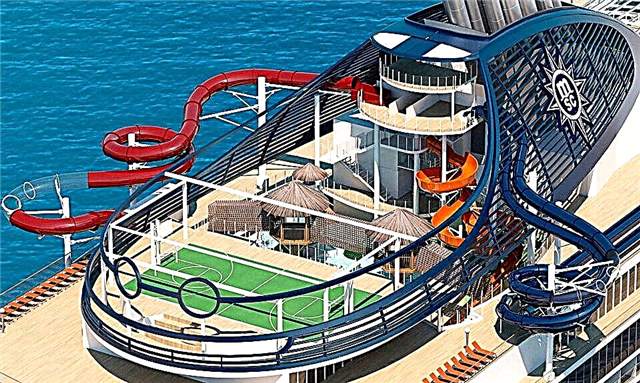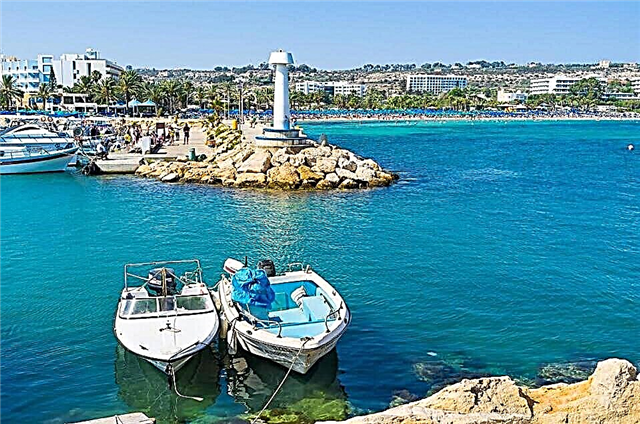People come to the St. John the Baptist monastery to pray, look at the monuments of Russian architecture and especially at the unique wooden church of the Life-Giving Trinity. Nowadays, the ancient monastery has the status of a courtyard of the Dormition monastery of Sviyazhsk. The two monasteries are separated by only a hundred meters, and together they occupy a third of the island - almost an entire Lavra!
The history of the monastery
A convent on the Kazan land appeared in the 16th century, but the exact date of its foundation is unknown. We can only say with certainty that the first population of Sviyazhsk was male. Russian warriors settled here, so at first the men's monasteries were created.

Sviyazhsky John the Baptist Monastery from a bird's eye view
The history of the convent began with the parish church of the Nativity of Christ. A small sister community arose at the wooden church. The nuns, who decided to retire from worldly life, prayed, kept house and built tiny wooden cells for themselves. In those days, the monastery did not have its own lands, so it existed due to rare subsidies from the state and alms.

View of the Sviyazhsky John the Baptist Monastery from Alexandrovskaya Street
According to historians, the monastery was known outside the Middle Volga region. From 1718 to 1726, the nun Varvara Golovkina served here in exile, who was later transferred to one of the Moscow monasteries by the decree of the tsar.
In May 1795, there was a massive fire that destroyed all the wooden buildings and the only brick church. Nuns and novices had nowhere to live. Abbess Maria went out with a petition to the local diocese, and she handed over the empty buildings of the closed Holy Trinity Monastery in Sviyazhsk to the monastery.

View of the Holy Gates
The Holy Synod allocated a subsidy of 500 rubles for the maintenance of the nursing community. In addition, the monastery was granted hay and arable land, fishing grounds and a flour mill on the Sulitsa River.
Life finally turned its bright side to the nuns, and the monastery began to flourish. Over the course of several years, the accumulated and received money was used to build new outbuildings, stone buildings for the nuns, a high bell tower and a side-chapel to the old Sergius Church.

From left to right: Church of the Life-Giving Trinity, Cathedral of the Icon of the Mother of God "Joy of All Who Sorrow", Church of St. Sergius of Radonezh
The abbess and Archbishop Ambrose of Kazan did a lot to improve the monastery. Not only local residents came to the monastery churches, but also pilgrims from distant lands. Incomes were growing, so in the 1830s the monastery acquired a solid stone fence, and at the end of the 19th century it received a gift of a spacious urban household opposite the Holy Gates.
Active construction continued until the beginning of the last century, the ancient monastery looked great. The nursing community numbered 400 people. It was the second largest monastery in the diocese. The hardworking nuns worked in the infirmary and the hospice. Every year, on the next Sunday after Easter, the icon of the Mother of God of All Who Sorrow was solemnly carried out from the main monastery church and a crowded procession was held in the towns and villages of the province.

Cathedral of the Icon of the Mother of God "Joy of All Who Sorrow"
In 1913, the Grand Duchess Elizabeth Feodorovna visited the monastery. Returning to Moscow from a trip to Kazan, she stopped in Sviyazhsk. The nuns and abbess greeted the distinguished guest with all the honors. The Grand Duchess prayed in the cathedral and visited the old camp church, which belonged to the Russian Tsar Ivan IV the Terrible.
After the revolution, everything changed. In 1919 the old monastery was closed. All the nuns were dispersed, and the monastery lands and buildings were given to the newly created state farm. A little later, the churches and buildings were transferred to the balance of the Sviyazhsky Museum-Reserve. For several decades, much has been destroyed, including no trace of the burials left at the monastery necropolis.

View of the domes of the Cathedral of the Icon of the Mother of God "Joy of All Who Sorrow"
Architectural monuments and shrines
Despite the long years of oblivion, the architectural ensemble has been preserved quite well. It consists of the surviving buildings of the old Holy Trinity-Sergius Monastery and buildings that appeared here in the 19th and early 20th centuries.
The central place is occupied by the Cathedral dedicated to the icon of the Mother of God "Joy of All Who Sorrow". The magnificent temple was erected at the turn of the XIX-XX centuries according to the project of the talented diocesan architect Fyodor Nikolaevich Malinovsky with money invested by the Moscow industrialist Sergei Semenovich Meshkov. The large neo-Byzantine cathedral stands on a hill, under all the winds. It noticeably dominates the other buildings on the island and attracts the attention of everyone who comes to the monastery.

In the Cathedral of the Icon of the Mother of God "Joy of All Who Sorrow"
The most ancient monument on the territory of the John the Baptist Monastery and the entire Middle Volga region is the picturesque wooden church of the Life-Giving Trinity. A modest one-domed church was built without a single nail at the same time as a wooden fortress on the island city of Sviyazhsk. This happened in 1551, even before the capture of Kazan. In the 19th century, the dilapidated temple was rebuilt. The builders replaced the hipped dome with an onion dome and covered the roof with durable iron sheets.
Throughout its long history, the Trinity Church has become overgrown with legends. It is believed that it was erected in just one day, and the logs for construction were delivered by water from the forests near Uglich. According to legend, it was in this church that Tsar John IV the Terrible prayed before the decisive assault on Kazan.

Church of St. Sergius of Radonezh
The unique temple has a great cultural and historical value and is one of the most famous sights of Tatarstan. Inside, it looks like an ordinary peasant hut. The ancient iconostasis from the temple can be seen in the State Museum of Fine Arts of Tatarstan, in Kazan.
To the south of the Trinity Church rises the white temple of St. Sergius of Radonezh. The two-storey building of hewn stone blocks was built in 1604 by Pskov craftsmen who worked in Kazan at the invitation of the Russian Tsar. The builders have erected powerful thick walls, so it is rather cramped inside. Old frescoes have been preserved on the outer wall. The Royal Doors from the Sergius Church are exhibited in the Museum of Fine Arts of Tatarstan.

In the northern corner of the monastery fence you can see a small but very beautiful chapel of Nicholas and Alexandra, the Royal Passion-bearers. The graceful temple is crowned with a rounded helmet-shaped dome, and its walls are decorated with an elegant red-brick pattern. The chapel was built simultaneously with the monastery cathedral, according to the project of one architect, so both buildings look harmoniously next to each other.
In addition to churches, the monastery has preserved the complex of the zemstvo hospital, residential and outbuildings of the 1820-1890s. The territory of the monastery is small, but cozy. Many places offer a picturesque view of the Sviyaga River.

View of the Church of the Life-Giving Trinity from the territory of the monastery
Useful information for pilgrims and tourists
They are allowed to enter the Sviyazhsky monastery any day - from morning to evening. The entrance is from Troitskaya Street. Visitors are asked to respect the monastery charter, observe silence, not take photographs of monks and novices, and also not take photos and videos inside the cathedral and churches.
You can go around the territory by yourself or with a guide. Most of the guests come from 9:00 to 16:00. Towards evening, sightseers are not taken to Sviyazhsk, so it becomes very quiet and calm in the monastery.

View of the Church of the Life-Giving Trinity from Trinity Street
Church services are held daily in the churches. There is a church shop at the monastery, where they sell Orthodox literature, icons, souvenirs, fresh pastries and tea.
Those who want to spend the night can stay at the pilgrim's monastery house. It is arranged like a hostel with separate rooms for men and women. Accommodation is not expensive, there are a lot of people who want to stay, so it is worth negotiating in advance.

View of the iconostasis of the Church of the Life-Giving Trinity
How to get there
The territory of the monastery is located on an island - between Troitskaya Street and the embankment of the Sviyaga River. From Kazan to Sviyazhsk 49 km - 1-1.5 hours drive. The easiest way to get there is by car or taxi. From the city you need to go along the M-7 highway towards Moscow. After the bridge over Sviyaga and the village of Isakov, turn towards the Sviyazhsk signboard and drive to the island.

View of the chapel of Nicholas and Alexandra, the Royal Passion-bearers
The bus from Kazan leaves only on weekends, at 8:40 am. Electric trains from the Kazan-Passenger station run daily. You need to get off at the Sviyazhsk station and get to the monastery by taxi. In summer, you can take a motor ship from the Kazan river port to the island in a couple of hours.
Attraction rating:











